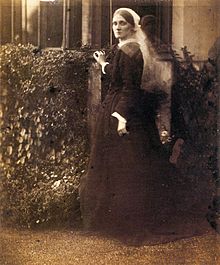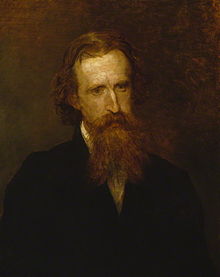Leslie Stephen
King's College, London Trinity Hall, Cambridge | |
|---|---|
| Spouses |
|
| Children | |
| Parents |
|
| Relatives | See list
|
Sir Leslie Stephen
Life
This article needs additional citations for verification. (March 2024) |
Sir Leslie Stephen came from a distinguished intellectual family,
His family had belonged to the
In 1859, he was
Marriage
(1) Harriet (Minny) Thackeray 1867–1875


The family connections included that of
After the wedding they travelled to the
After Minny's death, Leslie Stephen continued to live with Anny, but they moved to 11 Hyde Park Gate South in 1876, next door to her widowed friend and collaborator, Julia Duckworth. Leslie Stephen and his daughter were also cared for by his sister, the writer
(2) Julia Duckworth 1878–1895

His second marriage was to Julia Prinsep Duckworth (née Jackson, 1846–1895). Julia had been born in India and after returning to England she became a model for Pre-Raphaelite painters such as Edward Burne-Jones.[7] In 1867, she had married Herbert Duckworth (1833 − 1870) by whom she had three children prior to his death in 1870.
Leslie Stephen and Julia Duckworth were married on 26 March 1878. They had four children:
- Vanessa (1879–1961), who married Clive Bell
- Thoby (1880–1906)
- Virginia (1882–1941), who married Leonard Woolf
- Adrian (1883–1948)
In May 1895, Julia died of influenza, leaving her husband with four young children aged 11 to 15 (her children by her first marriage being adult by then).[8]
Career
In the 1850s, Stephen and his brother James were invited by
Stephen was an
In his spare time, he participated in athletics and
During the eleven years of his editorship, in addition to three volumes of critical studies, he made two valuable contributions to philosophical history and theory. The first was The History of English Thought in the Eighteenth Century (1876 and 1881). This work was generally recognised as an important addition to philosophical literature and led immediately to Stephen's election at the Athenaeum Club in 1877. The second was The Science of Ethics (1882). It was extensively adopted as a textbook on the subject and made him the best-known proponent of evolutionary ethics in late-nineteenth-century Britain. He was elected a member of the American Antiquarian Society in 1901.[11]
Leslie Stephen also served as the first editor (1885–91) of the Dictionary of National Biography. He was appointed a Knight Commander of the Order of the Bath (KCB) in the 1902 Coronation Honours list published on 26 June 1902.[12][13]
Humanism
As an adult, Stephen was an
He advocated for more people of this view to claim the label "agnostic" for themselves, eschewing the harder associations of the unadorned term "atheist", reflecting the fact that no one who claims a disbelief in gods does so on the basis of professing absolute knowledge about the universe. He concluded his essay "An Agnostic's Apology" with a reply to religious critics who hold atheists and agnostics in contempt:
"Til then, we shall be content to admit openly what you whisper under your breath or hide in technical jargon, that the ancient secret is secret still; that man knows nothing of the Infinite and Absolute; and that, knowing nothing, he had better not be dogmatic about his ignorance. And, meanwhile, we will endeavour to be as charitable as possible, and whilst you trumpet forth officially your contempt for our skepticism, we will at least try to believe that you are imposed upon by your own bluster."
— Leslie Stephen[15]
Stephen was very involved in the organised
Mountaineering

Stephen was one of the most prominent figures in the golden age of alpinism (the period between Wills's ascent of the Wetterhorn in 1854 and Whymper's ascent of the Matterhorn in 1865) during which many major alpine peaks saw their first ascents. Joining the Alpine Club in 1857 (the year of its formation), Stephen made the first ascent, usually in the company of his favourite Swiss guide Melchior Anderegg, of the following peaks:
- Wildstrubel – 11 September 1858 with T. W. Hinchliff and Melchior Anderegg
- Bietschhorn – 13 August 1859 with Anton Siegen, Johann Siegen and Joseph Ebener
- Rimpfischhorn – 9 September 1859 with Robert Living, Melchior Anderegg and Johann Zumtaugwald
- Alphubel – 9 August 1860 with T. W. Hinchliff, Melchior Anderegg and Peter Perren
- Blüemlisalphorn – 27 August 1860 with Robert Living, Melchior Anderegg, F. Ogi, P. Simond and J. K. Stone
- Schreckhorn – 16 August 1861 with Ulrich Kaufmann, Christian Michel and Peter Michel
- Monte Disgrazia – 23 August 1862 with E. S. Kennedy, Thomas Cox and Melchior Anderegg
- Zinalrothorn – 22 August 1864 with Florence Crauford Grove, Jakob Anderegg and Melchior Anderegg
- Mont Mallet – 4 September 1871 with G. Loppe, F. A. Wallroth, Melchior Anderegg, Ch. and A. Tournier
He was President of the Alpine Club from 1865 to 1868 and edited the Alpine Journal, 1868–1872.
List of selected publications
- The Poll Degree from a Third Point of View (1863).
- The "Times" on the American War: A Historical Study (1865).
- Sketches from Cambridge (1865).
- The Playground of Europe (1871).
- Essays on Free Thinking and Plain Speaking (1873).
- Hours in a Library (3 vols., 1874–1879).
- The History of English Thought in the Eighteenth Century (2 vols., 1876).
- Samuel Johnson (1878).
- Swift (1882).
- The Science of Ethics (1882).
- Life of Henry Fawcett (1885).[18]
- An Agnostic's Apology and Other Essays (London: Smith, Elder and Company, 1893).
- Sir Victor Brooke, Sportsman and Naturalist (1894).
- The Life of Sir James Fitzjames Stephen, Bart., K.C.S.I. (1895).
- Social Rights and Duties (1896).
- Studies of a Biographer (4 volumes, 1898–1902).
- The English Utilitarians (1900).
- George Eliot (London: Macmillan, 1902).
- English Literature and Society in the Eighteenth Century (Ford Lectures) (London: Duckworth and Company, 1903, 1904).
- Hobbes (1904).
- Stephen, Leslie (1977). Bell, Alan S (ed.). Sir Leslie Stephen's Mausoleum Book. Clarendon Press. ISBN 978-0-19-812084-1.
Death

He died in Kensington and is buried in the eastern section of Highgate Cemetery in the raised section alongside the northern path. His daughter, Virginia Woolf, was badly affected by his death and she was cared for by his sister, Caroline.[5] Woolf in 1927 created a detailed psychological portrait of him in the fictional character of Mr. Ramsay in her classic novel, To the Lighthouse, (as well as of her mother as Mrs. Ramsay). (Ref: The Diaries and Letters of Virginia Woolf) His probate is worded: STEPHEN sir Leslie of 22 Hyde Park-gate Middlesex K.C.B. probate London 23 March to George Herbert Duckworth and Gerald de L'Etang Duckworth esquires Effects £15715 6s. 6d.[19]
To honour his memory, his friends held a lecture in 1907 at the University of Cambridge, which has been held bi-annually as the Leslie Stephen Lecture since. His friends endowed that it be held with the specification that it be on "some literary subject, including therein criticism, biography and ethics."[20]
Family tree
For family trees of the Stephens, Thackerays and Jacksons, see Bicknell (1996a)[21] and Bloom and Maynard (1994).[22]
| Stephen family tree[23][24] | |||||||||||||||||||||||||||||||||||||||||||||||||||||||||||||||||||||||||||||||||||||||||||||||||||||||||||||||||||||||||||||||||||||||||||||||||||||||||||||||||||||||||||||||||||||||||||||||||||||||||||||||||||||||||||||||||||||||||||||||||||||||||||||||||||||||||||||||||||||||||||||||||||||||||||||||||||||||||||||||||||||||||||||||||||||||||||||||||||||
|---|---|---|---|---|---|---|---|---|---|---|---|---|---|---|---|---|---|---|---|---|---|---|---|---|---|---|---|---|---|---|---|---|---|---|---|---|---|---|---|---|---|---|---|---|---|---|---|---|---|---|---|---|---|---|---|---|---|---|---|---|---|---|---|---|---|---|---|---|---|---|---|---|---|---|---|---|---|---|---|---|---|---|---|---|---|---|---|---|---|---|---|---|---|---|---|---|---|---|---|---|---|---|---|---|---|---|---|---|---|---|---|---|---|---|---|---|---|---|---|---|---|---|---|---|---|---|---|---|---|---|---|---|---|---|---|---|---|---|---|---|---|---|---|---|---|---|---|---|---|---|---|---|---|---|---|---|---|---|---|---|---|---|---|---|---|---|---|---|---|---|---|---|---|---|---|---|---|---|---|---|---|---|---|---|---|---|---|---|---|---|---|---|---|---|---|---|---|---|---|---|---|---|---|---|---|---|---|---|---|---|---|---|---|---|---|---|---|---|---|---|---|---|---|---|---|---|---|---|---|---|---|---|---|---|---|---|---|---|---|---|---|---|---|---|---|---|---|---|---|---|---|---|---|---|---|---|---|---|---|---|---|---|---|---|---|---|---|---|---|---|---|---|---|---|---|---|---|---|---|---|---|---|---|---|---|---|---|---|---|---|---|---|---|---|---|---|---|---|---|---|---|---|---|---|---|---|---|---|---|---|---|---|---|---|---|---|---|---|---|---|---|---|---|---|---|---|---|---|---|---|---|---|---|---|---|---|---|---|---|---|---|---|---|---|---|---|---|---|---|---|---|---|---|---|---|---|---|
| |||||||||||||||||||||||||||||||||||||||||||||||||||||||||||||||||||||||||||||||||||||||||||||||||||||||||||||||||||||||||||||||||||||||||||||||||||||||||||||||||||||||||||||||||||||||||||||||||||||||||||||||||||||||||||||||||||||||||||||||||||||||||||||||||||||||||||||||||||||||||||||||||||||||||||||||||||||||||||||||||||||||||||||||||||||||||||||||||||||
References
- ^ a b Luebering 2006.
- ^ ACAD & STFN850L.
- ^ Hobhouse, Hermione. "The Alexander estate Pages 168-183 Survey of London: Volume 42, Kensington Square To Earl's Court. Originally published by London County Council, London, 1986". British History Online. Retrieved 24 July 2020.
- ^ a b Bicknell 1996a, p. [page needed].
- ^ a b Lewis, Alison M (Spring 2001). "Caroline Stephen and her niece, Virginia Woolf". Journal of the Fellowship of Quakers in the Arts (21). Retrieved 10 December 2015.
- ^ Bloom & Maynard 1994.
- ^ Smith College libraries biography of Julia Prinsep Stephen
- ^ Gérin 1981, p. 178.
- ^ J. F. C. Harrison, A History of the Working Men's College (1854–1954), Routledge Kegan Paul (1954)
- ^ "University intelligence". The Times. No. 36623. London. 27 November 1901. p. 6.
- ^ American Antiquarian Society Members Directory
- ^ "The Coronation Honours". The Times. No. 36804. London. 26 June 1902. p. 5.
- ^ "No. 27453". The London Gazette. 11 July 1902. p. 4441.
- ^ Frederic William Maitland, ed. (2012). The Life and Letters of Leslie Stephen. p. 133.
- ^ Stephen, Leslie (2007). "An Agnostic's Apology". In Christopher Hitchens (ed.). The Portable Atheist. Da Capo Press. p. 111.
- ^ Fenwick, Gillian (1993). Leslie Stephen's life in letters: a bibliographical study. p. 125.
- ^ Sir Leslie Stephen (2002). Social Rights And Duties: Addresses to Ethical Societies (Complete). Library of Alexandria.
- Westminster Review. 125: 83–95. 1886.
- ^ Archives 2018.
- ^ "Leslie Stephen Lecture 2010: The Dark Sixteenth Century". University of Cambridge. 29 October 2010. Retrieved 15 June 2021.
- ^ Bicknell 1996a, p. 1.
- ^ Bloom & Maynard 1994, p. xx.
- ^ Bell 1972, Family Tree pp. x–xi
- ^ Venn 1904.
Bibliography
- ISBN 978-0-394-53061-1.
- Bell, Alan (24 May 2012). "Stephen, Sir Leslie (1832–1904)". doi:10.1093/ref:odnb/36271. (Subscription or UK public library membershiprequired.)
- ISBN 978-0-15-693580-7.
- Bicknell, John W, ed. (1996a). Selected Letters of Leslie Stephen: Volume 1. 1864-1882. Basingstoke: ISBN 9781349248872.
- Bicknell, John W, ed. (1996b). Selected Letters of Leslie Stephen: Volume 2. 1882-1904. ISBN 978-0-8142-0691-1.
- Broughton, Trev Lynn (2004). Men of Letters, Writing Lives. ISBN 978-1-134-89156-6.
- Harrison, Frederic (1908). "Sir Leslie Stephen." In: Realities and Ideals. London: Macmillan & Co.
- Hutton, Richard Holt (1908). "Mr. Leslie Stephen and the Scepticism of Believers." In: Criticism on Contemporary Thought and Thinkers. London: Macmillan and Co.
- Hyman, Virginia R. (1980). "Concealment and Disclosure in Sir Leslie Stephen's "Mausoleum Book"". Biography. 3 (2): 121–131. S2CID 43408022.
- Luebering, J. E. (21 December 2006). "Sir Leslie Stephen". Encyclopædia Britannica. Retrieved 2 January 2018.
- MacCarthy, Desmond (1937). Leslie Stephen: The Leslie Stephen Lecture delivered before the University of Cambridge on 27 May 1937. CUP Archive.
- Duckworth & Co.Retrieved 2 January 2018.
- Stephen, Leslie (1977). Bell, Alan S (ed.). Sir Leslie Stephen's Mausoleum Book. Clarendon Press. ISBN 978-0-19-812084-1.
- Stephen, Leslie, ed. (1886). Dictionary of National Biography. vol. VIII Burton Cantwell. London: Elder, Smith & Co. (see also Dictionary of National Biography)
- ISBN 978-1-108-04492-9. also Internet archive
- Websites
- Kukil, Karen V. (2011). "Leslie Stephen's Photograph Album". Northampton MA: Smith College.
- "Julia Prinsep Stephen (1846 - 1895): wife/mother/writer/volunteer". Woolf, Creativity and Madness. Smith College. 22 March 2011. Retrieved 15 December 2017. Family tree
- "Stephen, Leslie (STFN850L)". A Cambridge Alumni Database. University of Cambridge. Retrieved 14 February 2018.
- "Find a will. Index to wills and administrations (1858-1995)". Calendars of the Grants of Probate and Letters of Administration. The National Archives. Retrieved 2 March 2018.
- Virginia Woolf (1922). "To the Lighthouse"
Anne Thackeray Ritchie
- Bloom, Abigail Burnham; Maynard, John, eds. (1994). Anne Thackeray Ritchie: Journals and letters. Columbus: Ohio State Univ. Press. ISBN 9780814206386.
- Gérin, Winifred (1981). Anne Thackeray Ritchie: a biography. Oxford: Oxford U.P. ISBN 9780198126645.
- Garnett, Henrietta (2004). Anny: A Life of Anny Thackeray Ritchie. London: ISBN 0-7011-7129-4.
External links
- Works by Leslie Stephen at Project Gutenberg
- Works by or about Leslie Stephen at Internet Archive
- Works by Leslie Stephen at LibriVox (public domain audiobooks)

- History of English Thought in the Eighteenth Century at Internet Archive.
- Obituary
- Leslie Stephen Photograph Album, Mortimer Rare Book Collection, Smith College Special Collections
